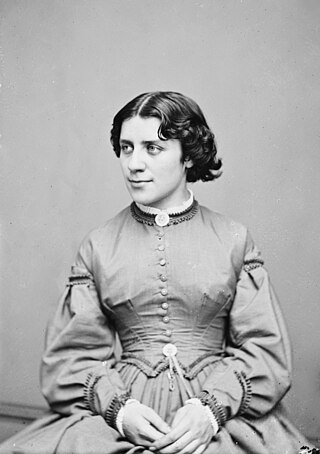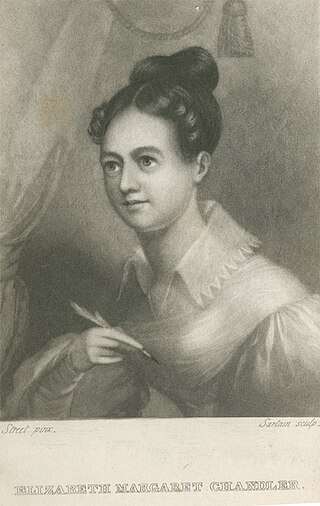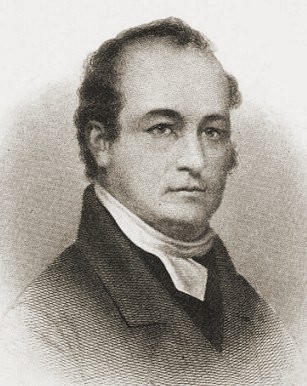
Lucy Stone was an American orator, abolitionist and suffragist who was a vocal advocate for and organizer promoting rights for women. In 1847, Stone became the first woman from Massachusetts to earn a college degree. She spoke out for women's rights and against slavery. Stone was known for using her birth name after marriage, contrary to the custom of women taking their husband's surname.

Anna Elizabeth Dickinson was an American orator and lecturer. An advocate for the abolition of slavery and for women's rights, Dickinson was the first woman to give a political address before the United States Congress. A gifted speaker at a very young age, she aided the Republican Party in the hard-fought 1863 elections and significantly influenced the distribution of political power in the Union just prior to the Civil War. Dickinson was the first white woman on record to summit Colorado's Longs Peak, Lincoln Peak, and Elbert Peak, and she was the second to summit Pike's Peak.

Theodore Dwight Weld was one of the architects of the American abolitionist movement during its formative years from 1830 to 1844, playing a role as writer, editor, speaker, and organizer. He is best known for his co-authorship of the authoritative compendium American Slavery as It Is: Testimony of a Thousand Witnesses, published in 1839. Harriet Beecher Stowe partly based Uncle Tom’s Cabin on Weld's text; the latter is regarded as second only to the former in its influence on the antislavery movement. Weld remained dedicated to the abolitionist movement until slavery was ended by the Thirteenth Amendment to the United States Constitution in 1865.

Lydia Maria Child was an American abolitionist, women's rights activist, Native American rights activist, novelist, journalist, and opponent of American expansionism. Her journals, both fiction and domestic manuals, reached wide audiences from the 1820s through the 1850s. At times she shocked her audience as she tried to take on issues of both male dominance and white supremacy in some of her stories.

Lane Seminary, sometimes called Cincinnati Lane Seminary, and later renamed Lane Theological Seminary, was a Presbyterian theological college that operated from 1829 to 1932 in Walnut Hills, Ohio, today a neighborhood in Cincinnati. Its campus was bounded by today's Gilbert, Yale, Park, and Chapel Streets.

Sarah Parker Remond was an American lecturer, activist and abolitionist campaigner.

Abby Kelley Foster was an American abolitionist and radical social reformer active from the 1830s to 1870s. She became a fundraiser, lecturer and committee organizer for the influential American Anti-Slavery Society, where she worked closely with William Lloyd Garrison and other radicals. She married fellow abolitionist and lecturer Stephen Symonds Foster, and they both worked for equal rights for women and for Africans enslaved in the Americas.

Betsy Mix Cowles was an early leader in the United States abolitionist movement. She was an active and influential Ohio-based reformer, and was a noted feminist and an educator. She counted among her friends and acquaintances people such as Frederick Douglass, William Lloyd Garrison, Henry C. Wright, and Abby Kelley Foster.

Laura Smith Haviland was an American abolitionist, suffragette, and social reformer. She was a Quaker and an important figure in the history of the Underground Railroad.

Elizabeth Margaret Chandler was an American poet and writer from Pennsylvania and Michigan. She became the first female writer in the United States to make the abolition of slavery her principal theme.

Anne Knight was an English social reformer, abolitionist and pioneer of feminism. She attended the 1840 Anti-Slavery convention, where the need to improve women's rights became obvious. In 1847 Knight produced what is thought to be the first leaflet for women's suffrage and formed the first UK women's suffrage organisation in Sheffield in 1851.

Myron Holley was an American politician who played a major role in the creation of the Erie Canal. In 1816, he was appointed to the five-person Erie Canal Commission, which had the task of organizing and supervising the canal's construction. As one of two full-time and salaried members of the commission, he was its treasurer and the supervisor for the construction of the canal's main route.
Stephen Symonds Foster was a radical American abolitionist known for his dramatic and aggressive style of public speaking, and for his stance against those in the church who failed to fight slavery. His marriage to Abby Kelley brought his energetic activism to bear on women's rights. He spoke out for temperance, and agitated against any government, including his own, that would condone slavery.
Julia Ward Williams Garnet was an American abolitionist who was active in Massachusetts and New York.

Harriet Forten Purvis was an African-American abolitionist and first generation suffragist. With her mother and sisters, she formed the first biracial women's abolitionist group, the Philadelphia Female Anti-Slavery Society. She hosted anti-slavery events at her home and with her husband Robert Purvis ran an Underground Railroad station. Robert and Harriet also founded the Gilbert Lyceum. She fought against segregation and for the right for blacks to vote after the Civil War.
The Ohio Women's Convention at Salem in 1850 met on April 19–20, 1850 in Salem, Ohio, a center for reform activity. It was the third in a series of women's rights conventions that began with the Seneca Falls Convention of 1848. It was the first of these conventions to be organized on a statewide basis. About five hundred people attended. All of the convention's officers were women. Men were not allowed to vote, sit on the platform or speak during the convention. The convention sent a memorial to the convention that was preparing a new Ohio state constitution, asking it to provide for women's right to vote.

Caroline F. Putnam was an American abolitionist and educator from Massachusetts, devoted herself in abolitionist movement and opened the Holley School for freed slaves.
James Bradley was an African slave in the United States who purchased his freedom and became an anti-slavery activist in Ohio.

Amos Dresser was an abolitionist and pacifist minister, and one of the founders of Olivet College. His name was well-known in the Antebellum period due to a well-publicized incident: in 1835 he was arrested, tried, convicted, and publicly whipped in Nashville, Tennessee for the crime of possession of abolitionist publications. The incident was widely reported and became well-known. Dresser published an account of it, and spoke of it frequently.
The Michigan Anti-Slavery Society, also called Michigan State Anti-Slavery Society, was founded on November 10, 1836, in Ann Arbor of the Michigan Territory (1805–1837). The first meeting was held at the First Presbyterian Church on East Huron Street. The founding of the anti-slavery society was part of a movement to abolish slavery in several states during the 1830s, as well as support within the territory for the Underground Railroad.















